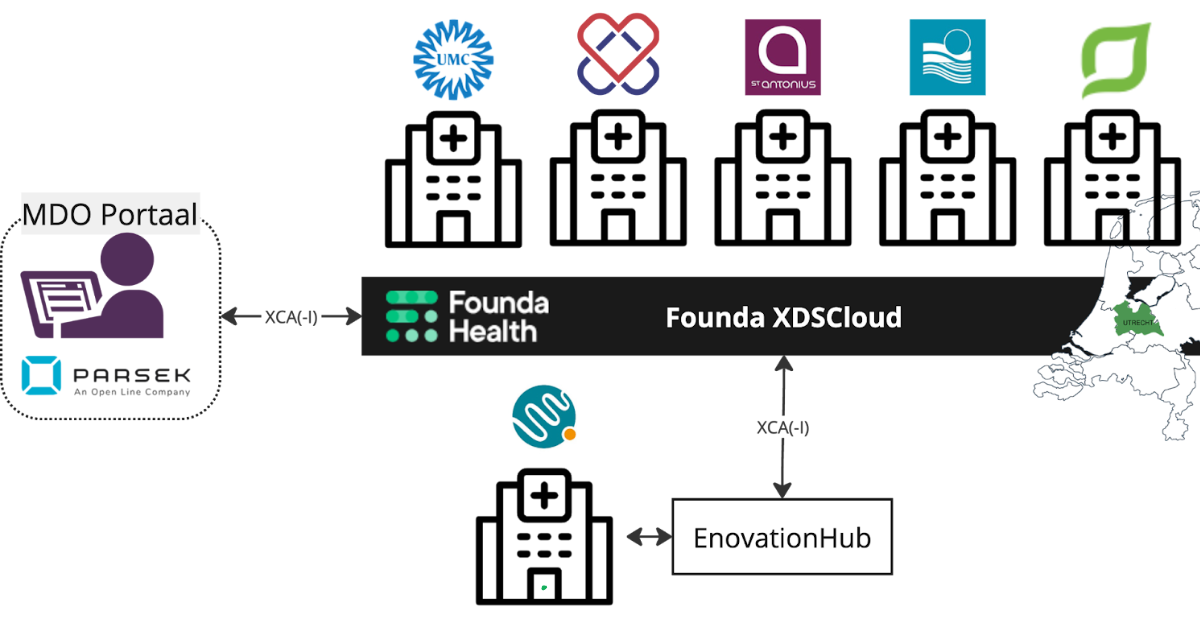Image Availability in Practice: MDT and XDS
In the Utrecht region, Open Line and Founda Health have been collaborating to support regional multidisciplinary team meetings (MDTs) within the Central Netherlands Data Sharing (DDMN) project.
This article explains how the Vitaly MDT Platform by Open Line utilizes the data made available through the Founda XDSCloud infrastructure to optimize the regional MDT process.
Background Information
Hospitals using the Founda XDSCloud Service share the medical information of their patients with other hospitals in accordance with laws and regulations. The DDMN region utilizes the Vitaly MDT Portal from Open Line to streamline the (regional) MDT process. Through integration with Founda Health, the Vitaly MDT Portal has access to the data of the connected hospitals, including access to data from the Chipsoft Healthcare Platform and Epic CareEverywhere. Founda and Enovation have connected their networks allowing all hospitals in the DDMNL region to share and exchange information.

Regional Infrastructure
Functional Description of an MDT Meeting
In short, the regional MDT process consists of five steps:
- Patient is "referred" to an MDT meeting
- Patient is scheduled for an MDT meeting
- Preparation for the MDT meeting
- MDT meeting takes place, and a "policy" is established
- The outcome of the MDT meeting is made available to the participants.
The collaboration between Open Line and Founda Health concerns steps 1, 3, and 5. During the registration and preparation steps of the MDT meeting, relevant patient information is collected and bundled so that it is readily available during the meeting. Images and/or reports can be linked to the request, making them immediately available during the MDT meeting. As part of step 4, the outcome of the MDT meeting is made available to the participants in the form of a report via XDS.
Functional Result
The aforementioned collaboration represents a significant step forward for an MDT participant. Instead of having to log in to multiple applications to get a comprehensive view of available patient information, all information now comes together in one overview in the MDT Portal.
MDT Referral
Because both images and reports are available within the MDT portal and can be viewed, there is no longer a need to manually transfer patient information from one system to another.
Viewing images pulled in via XDSCloud network in MDT Portal
This data availability ensures a more efficient MDT process and reduces the likelihood of (administrative) errors that slow down the process.
Integration based on international communication standards
The collaboration between Open Line and Founda Health is 100% based on international communication standards according to the IHE Cross-enterprise Document Sharing (XDS), IHE Cross-community Access (XCA), and IHE Cross-enterprise User Assertion (XUA) profiles. The implementation follows the "Technical Agreement - Dutch National HIE Network" delivered by the "Taskforce Samen Vooruit" in 2020.
The Vitaly MDT Portal conforms to the requirements imposed on the actors XUA X-Service-User and XCA(-I) Initiating Gateway, thereby supporting the ITI-38 (cross-gateway query), ITI-39 (cross-gateway retrieve), and RAD-75 (cross-gateway image retrieve) transactions. According to the XUA profile, information from the Vitaly user is included with each of these transactions (ITI-40).
XCA(-I) connections
The Founda Health XDSCloud implements the same transactions, acting as an "XUA X-Service-Provider" and "XCA Responding (Imaging) Gateway". Before a transaction is answered, the provided user information is used to determine whether it is allowed access to the requested information. The decision for this is made by the hospital being queried.
In addition to the aforementioned IHE profiles, the IHE Cross-enterprise Workflow (XDW) profile is also utilized to share information from the MDT process.
Author
Andries Hamster
Andries' expertise lies in the domain of "standards-based interoperability" to realize health information exchanges. Throughout his career he has been exposed to many interoperability standards such as DICOM, HL7 and he has been involved with IHE from the start.





